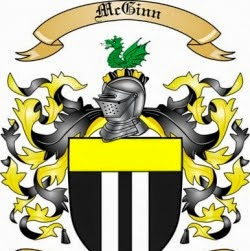Michael Anthony Mcginn
age ~58
from Pensacola, FL
- Also known as:
-
- Michael A Mcginn
- Michael M Mcginn
- Michael S Mcginn
- Mina Mcginn
- Micah A Mcginn
- Assimina J Mcginn
- Michael A Hafner
- Michael A Bosco
- Micheal Mcginn
- Michael Amc Ginn
- Phone and address:
-
5043 Yesteroaks Pl, Pensacola, FL 32504
(850)2071211
Michael Mcginn Phones & Addresses
- 5043 Yesteroaks Pl, Pensacola, FL 32504 • (850)2071211
- Phoenix, AZ
- Hartford, CT
- Glendale, AZ
Us Patents
-
System, Apparatus And Method For Voltage To Current Conversion
view source -
US Patent:6798289, Sep 28, 2004
-
Filed:May 31, 2002
-
Appl. No.:10/160348
-
Inventors:Michael McGinn - Tempe AZ
-
Assignee:Motorola, Inc. - Schaumburg IL
-
International Classification:H03F 345
-
US Classification:330252, 330261, 455214
-
Abstract:A voltage-to-current converter having improved third order distortion is disclosed herein for use in an FM radio system, particularly an FM radio system which employs a broadband input filter rather than a narrow band input filter. By cross-coupling a main amplifier with a second amplifier that produces more distortion and has a smaller g , than the main amplifier, third order frequency peaks resulting from non-linear amplification of undesired signals can be prevented from interfering with a desired signal because the magnitude of the third order frequency peak is reduced.
-
Tuning Signal Generator And Method Thereof
view source -
US Patent:7236756, Jun 26, 2007
-
Filed:Dec 13, 2002
-
Appl. No.:10/319188
-
Inventors:Michael McGinn - Tempe AZ, US
-
Assignee:Freescale Semiconductors, Inc. - Austin TX
-
International Classification:H04B 1/18
H04B 1/06
H04B 7/00 -
US Classification:4551931, 4551501, 4551802, 4551891, 4551922
-
Abstract:A front end tuning system includes a tuning signal generator. The tuning signal generator includes a digital-to-analog converter (DAC) to receive a pre-conditioned tuning signal at a reference input, to receive a digital value at a digital control input, and to produce a modified tuning signal based on the digital value and the pre-conditioned signal. Preconditioning the tuning-voltage allows a simple current type DAC to be can be used, rather than an 8-bit ladder type DAC used by some other front end tuners. Significant cost savings can be achieved because less memory is required to store the digital values supplied to the DACs, and set up times can be reduced. An adjustable temperature compensation circuit provides additional adaptability.
-
Bandgap Curvature Correction Circuit For Compensating Temperature Dependent Bandgap Reference Signal
view source -
US Patent:8446141, May 21, 2013
-
Filed:Jun 4, 2010
-
Appl. No.:12/794716
-
Inventors:Michael McGinn - Tempe AZ, US
-
Assignee:Maxim Integrated Products, Inc. - San Jose CA
-
International Classification:G05F 3/16
G05F 3/20 -
US Classification:323313, 323315
-
Abstract:A temperature compensated bandgap reference circuit includes a bandgap voltage generator having a temperature dependent signal output and a correction circuit coupled to the output of the bandgap voltage generator and generating a second order quadratic signal which is complementary to the signal output.
-
Stabilization Circuit And Method For Second Order Tunable Active Filters
view source -
US Patent:53250702, Jun 28, 1994
-
Filed:Jan 25, 1993
-
Appl. No.:8/008103
-
Inventors:Michael McGinn - Scottsdale AZ
-
Assignee:Motorola, Inc. - Schaumburg IL
-
International Classification:H03F 345
-
US Classification:330256
-
Abstract:An active filter circuit (10) that has a cut off frequency being substantially independent of absolute and temperature variations due to on chip resistors (R. sub. 1, R. sub. 2 and R. sub. 3) has been provided. The active filter includes a transconductance gain amplifier (16) having first and second currents (I. sub. B and I. sub. E) the ratio of which are controlled such that the absolute and temperature effects of any on chip resistors of the active filter circuit are removed. The ratio of the first and second currents of the transconductance gain amplifier are controlled by a circuit that generates third and fourth currents (I. sub. b and I. sub. e) which are a function of a bandgap voltage. The circuit then utilizes the third and fourth currents and provides, to the transconductance gain amplifier, a current that is substantially equal to the ratio of square of the third current to the fourth current, and a current substantially equal to the fourth current.
-
Crossover Circuit For Use In Automatic Gain Control Systems
view source -
US Patent:43933548, Jul 12, 1983
-
Filed:Dec 29, 1980
-
Appl. No.:6/220605
-
Inventors:Michael McGinn - Tempe AZ
-
Assignee:Motorola, Inc. - Schaumburg IL
-
International Classification:H03G 330
-
US Classification:330280
-
Abstract:A unity gain, closed loop, feedback amplifier is described which accurately defines the changeover point in an AGC system to provide a first output which varies in response to an AGC input signal and is indicative of the level thereof up to a predetermined threshold value and thereafter remains constant and then to provide a second output which is indicative of the applied AGC input signal becoming more positive than the threshold level. The amplifier changeover circuit comprises a first circuit loop and a second circuit loop coupled with a comparator amplifier which is adapted to receive the AGC input signal. With the AGC input signal being less than the threshold level the first circuit loop is responsive to increases in the input signal to provide an output signal which is indicative of the level thereof. During this region of the AGC input signal the second circuit loop is held non-responsive until such time that the AGC input signal becomes more positive than the threshold level at which time a second output a signal is produced therefrom which is indicative of the level of the AGC input signal. The output of the first circuit loop is maintained constant at a bias reference level during the interval that the second circuit loop is rendered responsive to the AGC input signal.
-
Balanced Variable Reactance Circuit And Method Of Producing The Same
view source -
US Patent:46382658, Jan 20, 1987
-
Filed:Jun 3, 1985
-
Appl. No.:6/740366
-
Inventors:Gerald K. Lunn - Scottsdale AZ
W. Eric Main - Mesa AZ
Michael McGinn - Scottsdale AZ -
Assignee:Motorola, Inc. - Schaumburg IL
-
International Classification:H03H 748
-
US Classification:333214
-
Abstract:A variable reactance, the value of which is controllable, is produced between a pair of terminals of a variable reactance circuit comprising a pair of current steering circuits. First and second reactive components are coupled respectively between the pair of terminals and the first and second current steering circuits to produce first and second antiphase reactive currents'. The first reactive current is split by the first current steering circuit into first and second antiphased proportional currents. Likewise, the second reactive current is split by the second current steering circuit into third and fourth antiphased proportional currents with said first and third currents being antiphased with respect to each other. The first reactive current is summed at a first one of the pair of terminals with said first and third currents while the second reactive current is summed at the second one of the pair of terminals with said second and fourth currents to produce the variable reactance across the terminals.
-
Sync Separator With Variable Bias Control
view source -
US Patent:43576290, Nov 2, 1982
-
Filed:Dec 29, 1980
-
Appl. No.:6/220611
-
Inventors:Michael McGinn - Tempe AZ
-
Assignee:Motorola, Inc. - Schaumburg IL
-
International Classification:H04N 508
-
US Classification:358153
-
Abstract:A variable slicing level is provided for the sync pulse separator of a television (TV) receiver to enable proper sync signal separation from the video signal as the strength of the received signal changes. The automatic gain control (AGC) signal is used to vary the conduction of at least a single additional transistor to move the slicing level toward or away from the sync pulse tip depending upon the strength of the received signal.
-
Adjustable Phase Shift Circuit
view source -
US Patent:47453702, May 17, 1988
-
Filed:Aug 30, 1987
-
Appl. No.:7/081085
-
Inventors:Michael McGinn - Scottsdale AZ
-
Assignee:Motorola, Inc. - Schaumburg IL
-
International Classification:H03F 345
-
US Classification:330252
-
Abstract:A circuit for shifting the phase of an applied differential input signal is disclosed which includes first and second differential amplifiers each having an input across which the input signal is applied, each differential amplifier having an input and an output transistor the emitters of which are coupled together via a respective capacitor. A first resistor is coupled between the emitter of the input transistor of first one of the differential amplifiers and the emitter of the output transistor of the second differential amplifier while a second resistor is coupled between the emitter of the input transistor of the second differential amplifier and the emitter of the output transistor of the first differential amplifier.
License Records
Michael A Mcginn
License #:
NS094821A - Expired
Category:
Real Estate Commission
Type:
Real Estate Salesperson-Standard
Resumes

Personal Trainer
view sourceLocation:
1776 Polk St, Hollywood, FL 33020
Industry:
Health, Wellness And Fitness
Work:
Inside/Out Health & Fitness, LLC
Personal Trainer
Personal Trainer

Owner
view sourceLocation:
5020 north 70Th St, Paradise Valley, AZ 85253
Industry:
Motion Pictures And Film
Work:
scout arizona since Apr 1988
Owner
Owner
Education:
Arizona State University 1982 - 1986
Bachelor's degree Finance
Bachelor's degree Finance
Skills:
Film Production
Video Production
Feature Films
Commercials
Film
Sill Photography Production
Documentaries
Post Production
Independent Film
Short Films
Hd Video
Music Videos
Camera
Cinematography
Pre Production
Producing
Television
Video Production
Feature Films
Commercials
Film
Sill Photography Production
Documentaries
Post Production
Independent Film
Short Films
Hd Video
Music Videos
Camera
Cinematography
Pre Production
Producing
Television

Michael Mcginn
view source
It And Desktop Support
view sourceWork:
Company Voice
It and Desktop Support
It and Desktop Support

Michael Mcginn
view source
Michael Mcginn
view source
Michael Mcginn
view source
Michael Mcginn
view sourceLocation:
United States
Name / Title
Company / Classification
Phones & Addresses
Secretary
VINCENZ HOMEOWNERS ASSOCIATION
1600 W Broadway Rd #200, Tempe, AZ 85282
#200, Tempe, AZ 85282
#200, Tempe, AZ 85282
MIKE'S MAID SERVICE, LLC
INTEGRITY TEXTILE SERVICES CO
MCGINN BUILDING LLC
2525 E Camelback #720, Phoenix, AZ 85016
6701 N Scottsdale Rd #35, Scottsdale, AZ 85250
6701 N Scottsdale Rd #35, Scottsdale, AZ 85250
Lawyers & Attorneys

Michael Mcginn - Lawyer
view sourceISLN:
911917596
Admitted:
1990
Law School:
Nova Southeastern University - Shepard Broad Law Center, JD - Juris Doctor, 1990

Michael Mcginn - Lawyer
view sourceISLN:
921401641
University:
George Mason University, School of Public Policy, 2008; James Madison University, B.A., 2000
Vehicle Records
-
Michael Mcginn
view source -
Address:5043 Yesteroaks Pl, Pensacola, FL 32504
-
VIN:1A8HX58257F510300
-
Make:CHRYSLER
-
Model:ASPEN
-
Year:2007
Myspace
Googleplus

Michael Mcginn
Work:
RainMaker Signs, Inc - Owner / President (2013)
Rhapsody International Inc - VP Customer Experience (2008-2013)
Expedia (2000-2006)
Northwest Airlines (1993-1999)
TripHub (2006-2008)
Rhapsody International Inc - VP Customer Experience (2008-2013)
Expedia (2000-2006)
Northwest Airlines (1993-1999)
TripHub (2006-2008)
Education:
Tuck School of Business - Management, Dartmouth College - Psychology

Michael Mcginn
Work:
Law Office of Michael C. McGinn, P.A. - Owner (2004)
Law Office of Curry & Associates - Attorney (2003-2004)
Office of the State Attorney, 10th Judicial Circuit - Assistant State Attorney (2000-2003)
Law Office of Curry & Associates - Attorney (2003-2004)
Office of the State Attorney, 10th Judicial Circuit - Assistant State Attorney (2000-2003)

Michael Mcginn
Education:
University of the West of England - Media, Godalming College - Media, History, Business, English
Tagline:
Straight talking, hairy, energetic kinda guy with lots of pointless anecdotes!

Michael Mcginn

Michael Mcginn

Michael Mcginn

Michael Mcginn

Michael Mcginn
Flickr
Plaxo

Michael McGinn
view sourceSan Francisco, CAManaging Partner at RSF Real Estate Advisors Past: Sr VP - Partner at Commercial Partners

Michael McGinn
view sourceSan Francisco, CASpecializing in tenant representation for office properties.

Michael McGinn
view sourceRhapsody America LLC
Classmates

Michael McGinn
view sourceSchools:
Northwestern Junior High School Battle Creek MI 1981-1983
Community:
Brandi Iles, Lorna Bell

Michael McGinn
view sourceSchools:
Flint River Academy Woodbury GA 1988-1992
Community:
Tommy Johns, Georgia Smith, Monica Kampel, Alan Washington, Anne Evans

Michael McGinn
view sourceSchools:
Carson City Crystal High School Carson City MI 1969-1973
Community:
Rebecca Kohn, David Clevenger

Michael McGinn
view sourceSchools:
California City Middle School California City CA 1990-1996
Community:
Lyonel Loundermon, Sherri Lester, Adrian Argueta

Michael McGinn
view sourceSchools:
MacArthur Middle School Ft. Meade MD 1968-1972, Carnes Creek Elementary School Toccoa GA 1969-1973
Community:
Tammy Harrell, Anthony Hunt, Tammy Glasgow

Michael McGinn
view sourceSchools:
Holy Innocents Episcopal School Atlanta GA 1999-2001
Community:
Steve Dimartino

Michael McGinn
view sourceSchools:
Algonquin Composite School North Bay Morocco 1955-1959
Community:
Richard Bedard, Debra Booth, Rob Paterson, Bob Blondin

Michael McGinn
view sourceSchools:
Frank Krznaric Memorial Whitney Public School Porcupine Morocco 1961-1970, Roland Michener Secondary High School South Porcupine Morocco 1972-1976
Community:
Paula Hoggett, Jackie Lachance, Richard Szewczyk, Tim Taylor
Youtube

Michael McGinn
view source
Michael James McGinn
view source
John Michael Mcginn
view source
Michael McGinn
view source
Michael McGinn
view source
Michael Mcginn
view source
Mike McGinn
view source
Michael McGinn
view sourceGet Report for Michael Anthony Mcginn from Pensacola, FL, age ~58


















